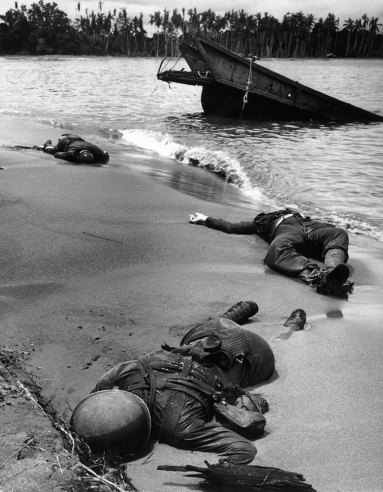
Posted Jan. 29, 2014
These are the images that compel us to look: the photos that come charged with high emotion and human drama. The images of war and conflict are especially arresting because of their life and death context.
Capturing the moment of death has a profound impact on the viewer. Robert Capa’s 1937 image of a “Falling Soldier” during the Spanish Civil War still speaks volumes today. The blurry black-and-white photo of Senator Robert F. Kennedy dying on the floor of a hotel kitchen in 1968 also tells a whole story of hope and despair. More recently, the crowd-sourced video of Neda Agha-Soltan, a young Iranian protester shot dead in the streets of Tehran in 2009, provides the story of conflict and election corruption.

Life Magazine’s iconic image of bodies on Buna Beach.
Photo by George Strock.
Now with video-equipped iPhones and other smartphones, the numbers of images grow into the millions each day whether made by professional photographers or amateurs. But only a few will achieve iconic status.
Some iconic images disgust: Iraqi prisoners humiliated and tortured in Abu Ghraib, or a South Vietnamese police official executing a prisoner with a single shot to his head during the Vietnam War.
They also may inspire, such as the lone Chinese dissident standing and blocking a column of tanks in Tiananmen Square. The older iconic photos keep their vitality: four generations still recognize the jubilant image of a sailor kissing a nurse in New York’s Times Square when V-J Day was announced and World War II ended.
These images easily substitute for a thousand or more words whether they are used to send a message, to symbolize compassion, to sum up a triumphant moment (raising the flag at Iwo Jima), to establish a poignant truth about the human condition (Kevin Carter’s photo of the vulture and the emaciated African child) or bring the reality of violence as close as possible.
Photos also may be used as propaganda, to score political points or even to mislead. So knowing the story behind the photo, even iconic photos that seem to sum up the entire story, is often to know more than what your eyes are telling you.
The story of the photograph of Buna Beach is one of the best illustrations of a single stark image that reflects the immediate consequences of battle and the sad, larger truth of war.
But it is the story behind the photo that provides insight into the tension and the cooperation that often exists between the media and the military.
The photograph was made well after Pearl Harbor and beginning of the American effort to beat back Imperial Japanese forces in the Pacific. From early 1942 until Japan’s surrender in 1945, the U.S. Army and Marine Corps were engaged in “island hopping,” fighting entrenched Japanese forces in places with familiar names —Guadalcanal, Okinawa, and the Marshall Islands.
As it became clear through the years of war, these were deadly battles and often the most dangerous moments were the first landing on the heavily defended beaches.
Buna Beach was one of the early engagements.
Through the first year of war, gruesome images of dead Japanese and German soldiers were shown in newsprint and on newsreels, but well into the war’s second year no one yet had seen a dead American despite the daily death and casualty reports from the War Department.
Access to images of the war and American troop deaths was kept from the American public by a decision of the White House and compliance by the military and the media.
Excerpt from Life’s editorial about the photo
Here lie three Americans [the editorial began].
What shall we say of them? Shall we say that this is a noble sight? Shall we say that this is a fine thing, that they should give their lives for their country?
Or shall we say that this is too horrible to look at?
Why print this picture, anyway, of three American boys dead upon an alien shore? Is it to hurt people? To be morbid?
Those are not the reasons.
The reason is that words are never enough. The eye sees. The mind knows. The heart feels. But the words do not exist to make us see, or know, or feel what it is like, what actually happens. The words are never right. . . .
The reason we print it now is that, last week, President Roosevelt and [Director of the Office of War Information] Elmer Davis and the War Department decided that the American people ought to be able to see their own boys as they fall in battle; to come directly and without words into the presence of their own dead.
And so here it is. This is the reality that lies behind the names that come to rest at last on monuments in the leafy squares of busy American towns.
SOURCE: Life.com
Concern about the public’s morale was real and long. Before the U.S. entered the war there had been lively debate between those who wanted to intervene in the fighting in Europe and isolationists who opposed American involvement in what they saw as a “European war.” Pearl Harbor silenced most of that and invigorated the American public to sign up for duty and ramp up production of war materiel.
President Franklin Roosevelt and his advisors, however, worried that images of dead American soldiers would be dispiriting to civilians just as the war effort moved into full swing. Widespread mobilization was under way and the administration insisted that any photos of dead Americans would hurt the war effort and harm national security.
The media agreed to go along with the military censorship.
In the offices of Life magazine, the nation’s premier photojournalism magazine, a young photo editor named A.B.C. (Cal) Whipple focused his attention on a photo taken of three dead American troops on a Pacific beach. Their bodies are half-buried in the sand; a destroyed landing craft is visible in the background. Their faces are not visible, but the image has a desolate, even haunting aspect.
The picture had been taken many months earlier by one of the magazine’s staff photographers, George Strock. Despite Whipple’s lobbying his editors and their entreaties to the Pentagon, military censors wouldn’t budge and the news media of the time would not think of going against their decision.
Whipple died just last year at 94 and his New York Times obituary quoted from a memoir he had written for his family about that photo. “I went from Army captain to major to colonel to general until I wound up in the office of an assistant secretary of the Air Corps, who decided, ‘This has to go to the White House.’”
Perhaps unbeknownst to Whipple and his editors, Roosevelt and his advisers already were worried that Americans were getting frustrated by the length of the war and the required rationing and shortages of everything from foods to nylon to rubber tires. The grumblers, Roosevelt and others felt, should be reminded that other Americans were making far greater sacrifices.
So in September 1943, nearly eight months after the Buna Beach fighting, Roosevelt and Elmer Davis, the director of the Office of War Information, gave Life editors permission to run Strock’s photo—and they gave it a full page in the large format magazine.
Opposite it, an editorial said that the administration believed “that the American people ought to be able to see their own boys as they fall in battle; to come directly and without words into the presence of their own dead.”
And, finally, one of the war’s most iconic photographs made it to the public’s eye, late and because of an ulterior motive, but also because of a journalist who recognized a stunning image and persisted in wanting to show the truth of battle.
Tim McNulty is co-director of the Medill National Security Journalism Initative and a lecturer at Northwestern University’s Medill School. He was a longtime foreign correspondent and senior editor at the Chicago Tribune. He helped direct the newspaper’s coverage of the September 11 tragedy, the American strike into Afghanistan and the invasion of Iraq.





